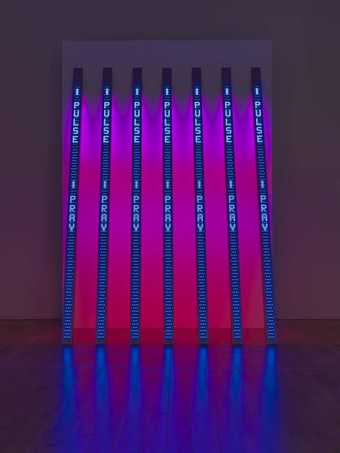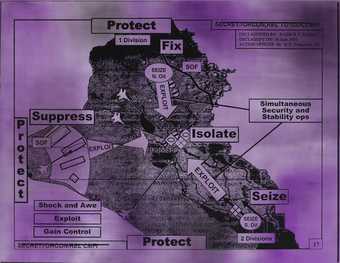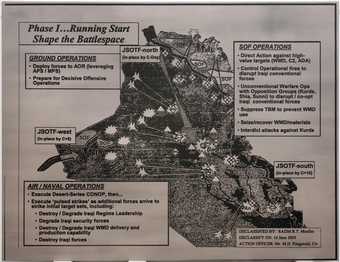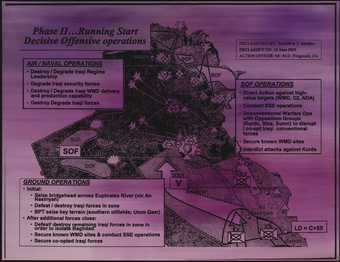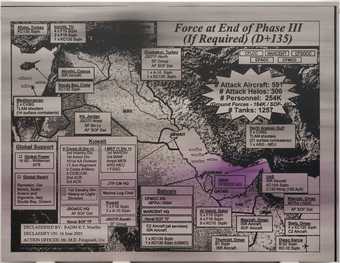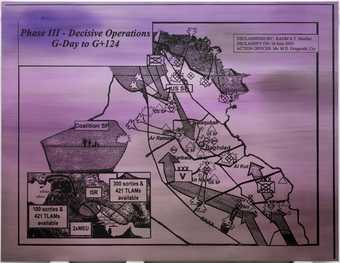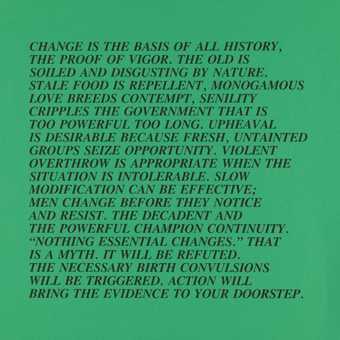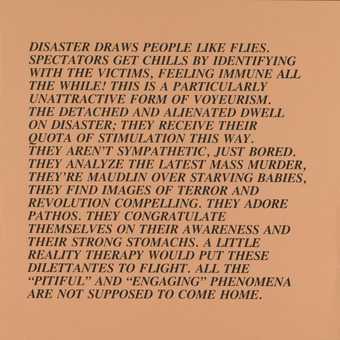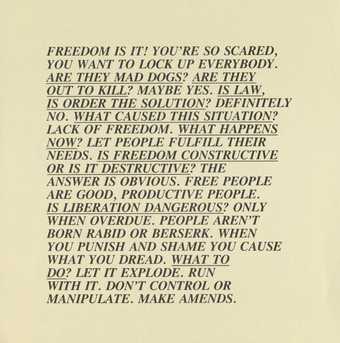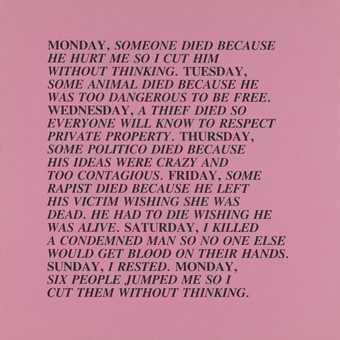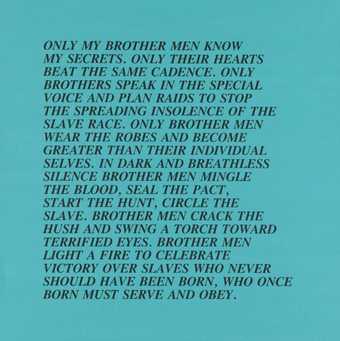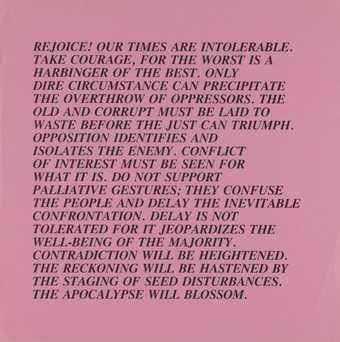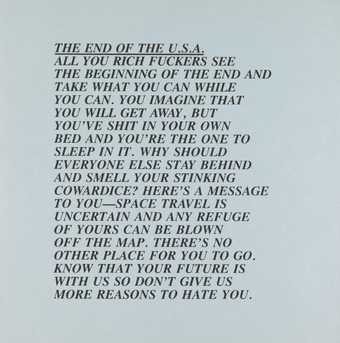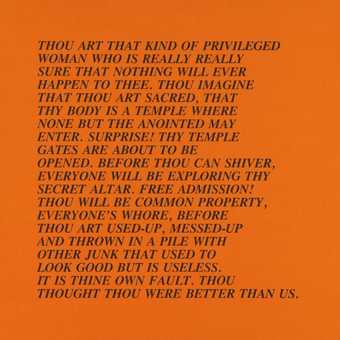
Not on display
- Artist
- Jenny Holzer born 1950
- Medium
- Oil paint on canvas
- Dimensions
- Support: 2011 × 2602 × 40 mm
- Collection
- ARTIST ROOMS Tate and National Galleries of Scotland
- Acquisition
- ARTIST ROOMS Acquired jointly with the National Galleries of Scotland through The d'Offay Donation with assistance from the National Heritage Memorial Fund and the Art Fund 2008
- Reference
- AR00084
Summary
In this work by American artist Jenny Holzer, an image of a military map of Iraq has been screen-printed onto a linen canvas covered in a thin, translucent layer of violet oil paint. The map was first photocopied onto clear film, called a photo-stencil, which was used in the screen-printing process to transfer the image onto the canvas. The dark shape of the country is positioned centrally and occupies about half of the canvas. It is framed by a thin rectangular border that does not accurately line up with the edges of the canvas. The map is scattered with military symbols: a chain of triangular observation posts crosses the centre of the country, military aircraft indicate the direction of flight lines and point to jagged-edged shapes suggesting explosions at several locations. The map’s place names are mostly obscured by the coded elements though Baghdad is clearly visible at its centre. Three inset boxes surround the map and provide further detail: in the bottom left corner an enlarged area of the country indicates the projected positions of the military; details of the original document’s declassification can be read in the top right corner; and the map’s title ‘Phase II – Shape the Battlespace / (A-Day to A+4) / 5 Days’ is written in large letters in the top left corner.
This large-scale canvas forms part of Holzer’s Redaction Paintings series, which the artist began making in 2006, and is one of six works from this series in the ARTIST ROOMS collection. Material for this series came from declassified US government documents, particularly those concerning national security, economic policy and foreign relations. Holzer began to use US government files in her work in 2004, taking advantage of the US 1966 Freedom of Information Act, which allows members of the public to request to see declassified documents. As the title of the Redaction Paintings series suggests (‘redaction’ refers to the censorship of sensitive information), many of the documents used in the series were made almost entirely illegible before their release, but this was not the case with the source image used for Shape the Battlespace, which has no areas crossed out or obscured. Holzer’s use of a photo-stencil to screen-print the image of the map allowed every element of the photocopied document to be reproduced in all its original detail, though without any explanatory key for the symbols and military acronyms used.
Shape the Battlespace makes no explicit critique of its subject matter, but by taking this map out of its military context and holding it up to public scrutiny in an art gallery, Holzer probes the boundaries between transparency and censorship, inviting viewers to reflect upon documentary evidence that offers an alternative reality to the images of war presented in the mass media, while avoiding sensationalist images or the direct representation of violence. The artist has explained her motivation to make such work: ‘As one becomes habituated to things, their intensity is dulled … in the last decades of the twentieth century, political rhetoric on all sides became so strident and inflated that obliqueness and artful understatement proved the most effective means of catching the attention of a weary public.’ (Quoted in Storr 2006, p.14.)
Described by the art critic Robert Storr as ‘a verbal maze of specialised terminology, acronyms, abbreviations, rote salutations and initials’ (Storr 2006, p.8), the Redaction Paintings were the first works on canvas Holzer exhibited in her career. Before this, she was known primarily for her language-based works, involving a variety of media including posters, LED screen works and projections.
Further reading
Robert Storr, Jenny Holzer: Redaction Paintings, New York 2006.
Cathy Lebowitz, ‘Protect Us From What We Don’t Know’, Art in America, vol.94, no.9, October 2006, pp.162–6.
Jenny Holzer: Protect Protect, exhibition catalogue, Museum of Contemporary Art Chicago 2010.
Florence Ritter
December 2011
Does this text contain inaccurate information or language that you feel we should improve or change? We would like to hear from you.
Online caption
Holzer’s works have a strong political emphasis, questioning how information is both controlled and received in the public domain. First exhibited at the Venice Biennale in 2007, this work forms part of a series of screenprints that reveal sensitive government transcripts relating to America’s intervention in the Middle East. Here Holzer uses a document from the National Security Archive, enlarging a military map of Iraq and setting it against a bright background. As with her earlier 'Truisms', language is Holzer’s primary concern, with the phrase "Shape the Battle Space" appearing sinisterly alongside strategic illustrations of the invasion.
Explore
- abstraction(8,615)
-
- non-representational(6,161)
-
- text(1,043)
- formal qualities(12,454)
-
- diagrammatic(799)
- social comment(6,584)
-
- war(358)
- inscriptions(6,664)
-
- arrow(29)
- map(56)
- printed text(1,138)
You might like
-
Jenny Holzer BLUE PURPLE TILT
2007 -
Jenny Holzer Protect Protect
2007 -
Jenny Holzer Phase I... Running Start Shape the Battlespace pewter
2007 -
Jenny Holzer Phase II... Running Start Decisive Operations violet
2007 -
Jenny Holzer Force at End of Phase III (If Required) violet
2007 -
Jenny Holzer Phase III - Decisive Operations violet
2007 -
Jenny Holzer [no title]
1979–82 -
Jenny Holzer [no title]
1979–82 -
Jenny Holzer [no title]
1979–82 -
Jenny Holzer [no title]
1979–82 -
Jenny Holzer [no title]
1979–82 -
Jenny Holzer [no title]
1979–82 -
Jenny Holzer [no title]
1979–82 -
Jenny Holzer [no title]
1979–82 -
Jenny Holzer Truisms
1984

